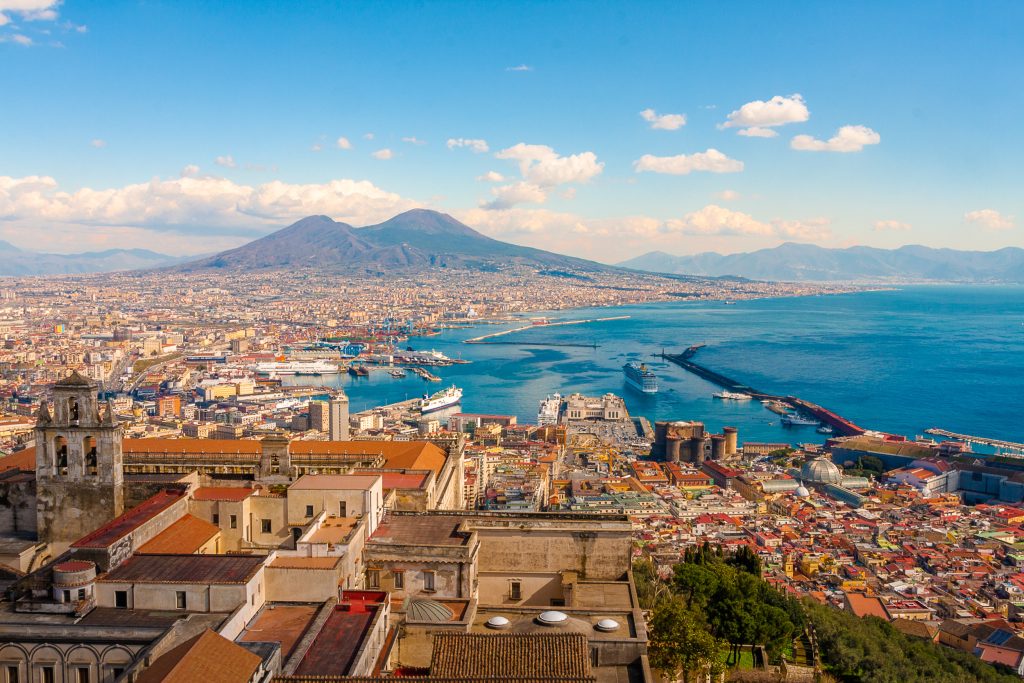Naples, a vibrant city on Italy’s southern coast, offers a rich historical tapestry woven from its ancient origins to its modern-day charm. Founded by Greek colonists around 600 BC and originally named Neapolis, or “New City,” Naples was strategically positioned to become a major hub of trade and culture in the ancient Mediterranean world.

The city’s Greek heritage is still evident in its historical sites, such as the ancient agora and the remnants of its Greek walls. By the 4th century BC, Naples had become a thriving center of Greek culture and thought, renowned for its philosophical schools and artistic achievements.
The Roman era marked another pivotal chapter in Naples’ history. During this time, the city became known for its luxurious villas and its role as a cultural retreat for Rome’s elite. The eruption of Mount Vesuvius in AD 79 had a profound impact on the region, burying nearby Pompeii and Herculaneum under volcanic ash. Despite this catastrophic event, Naples continued to flourish. The city’s wealth and status were bolstered during the Roman Empire, with the construction of grand structures such as the Roman amphitheater, which still stands as a testament to Naples’ importance during this period.
In the medieval era, Naples evolved under various rulers, including the Normans, Swabians, and Angevins. The city became the capital of the Kingdom of Naples in the 13th century, with its status further cemented under the Aragonese dynasty. This period saw the construction of impressive fortifications and the establishment of Naples as a major center of art and learning. The Gothic and Renaissance architecture of Naples reflects the city’s rich medieval heritage, with landmarks such as the Castel Nuovo and the Naples Cathedral serving as enduring symbols of its historical significance.
The 19th century brought significant change with the unification of Italy. Naples, once part of the Kingdom of the Two Sicilies, became integrated into the newly formed Kingdom of Italy. This transition was marked by modernization efforts, including the development of new infrastructure and the renovation of historic sites. Despite the challenges of this period, Naples maintained its vibrant cultural life, continuing to be a focal point for Italian arts, music, and cuisine. The city’s historical layers from various epochs are visible in its bustling streets, lively piazzas, and diverse architectural styles.
To fully appreciate Naples’ rich history and cultural heritage, exploring the city with City Sightseeing Napoli is highly recommended. This convenient hop-on, hop-off tour provides access to Naples’ key landmarks, including the historic center, the Royal Palace, and the San Carlo Theatre. With informative commentary and flexible travel options, City Sightseeing Napoli allows you to delve into the city’s past while enjoying its present vibrancy. Whether you’re interested in ancient ruins, medieval fortifications, or modern attractions, City Sightseeing Napoli offers an engaging and comprehensive way to experience the essence of Naples.
In summary, Naples is a city where ancient history and modern life converge in a dynamic blend. From its Greek origins to its Roman grandeur and medieval transformations, Naples offers a rich historical experience. With City Sightseeing Napoli, you can explore the city’s remarkable heritage and contemporary vibrancy, making for an unforgettable journey through one of Italy’s most captivating cities.

